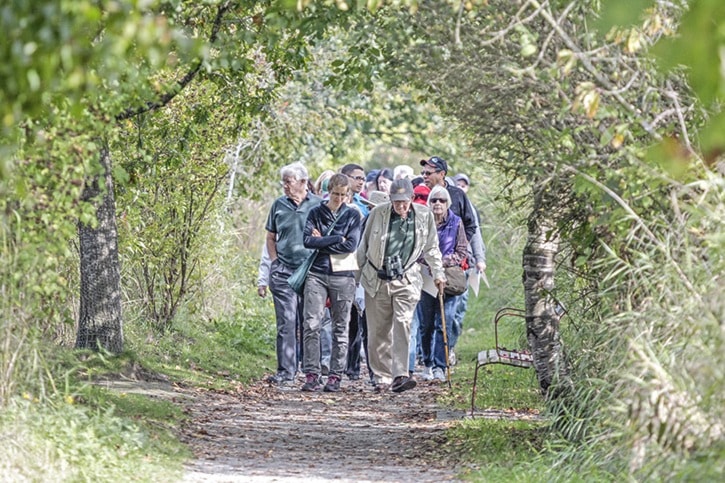It was a nature walk with a purpose.
Around 45 people set out for an hour-long stroll around Brydon Lagoon on Wednesday afternoon. Among them were members of the Langley Field Naturalists Society, City parks and engineering managers and a trio of City Councillors in whose hands the fate of the pond, where thousands of fish died during the B.C. Day long weekend, may very well rest.
Led by Langley Field Naturalists Rhys Griffiths and Anthea Farr, the purpose of the tour was to provide a history of the lagoon, discuss the challenges it is facing and to offer people enough information to begin brainstorming possible solutions.
"It's a special place — ideal for wildlife and wildlife viewing," said Farr, who is a past president of the Langley Field Naturalists Society and the person who wrote the original proposal to the City of Langley to turn the decommissioned sewer lagoon into a nature park.
In the mid-1980s, using grant money from the province, LFN members set about building nature trails, installing nest boxes, erecting educational signage, planting berry-producing shrubs to attract songbirds and creating a viewing area, among other improvements.
Within a few years, they noticed the diversity of plants and wildlife, as well as the number of people visiting the park, had increased significantly.
Farr recalled rowing to the centre of the lagoon, towing a raft that would become a resting place for the many species of waterfowl that either reside at Brydon Lagoon or stop there during their migration. When she lowered the raft's anchor into place, Farr said, it appeared to drop a fair distance.
Griffiths, also a past president of LFN, acknowledged that 15 years ago he broke the rules and went out in a boat to measure the pond's depth in several places. He found depths of between eight and 10 feet.
Today, the Field Naturalists estimate the pond is roughly half as deep because of the sediment that is building up on its bottom through the decay of plant life and particles being washed in through storm drains. This build-up, they say, is directly responsible for the deaths of thousands of fish over the August long weekend. During the long spell of hot summer weather, the shallow water quickly reached temperatures too high to support aquatic life, a subsequent independent study found.
The lagoon supports several species of fish, including carp, sunfish and three-spined stickleback, as well as frogs, newts, salamanders and turtles.
 "Much of Brydon Lagoon’s bird life and diversity was a result of fish being there," wrote Farr in a letter to The Times in August after the fish died.
"Much of Brydon Lagoon’s bird life and diversity was a result of fish being there," wrote Farr in a letter to The Times in August after the fish died.
"Although most were non-native species, these fish supported a large array of native birds. The lack of oxygen/aeration resulting in such a massive fish kill will negatively impact the cormorants, hooded and common mergansers, green and great blue herons, scaups, grebes, kingfishers, visiting osprey and resident pair of nesting bald eagles," she wrote.
In order to improve the pond's health, what is needed is more shade, deeper water and more efficient mixing of oxygen into the water, said Lisa Dreves, stewardship co-ordinator with the Langley Environmental Partners Society.
Dreves spoke to the gathering about water quality in the lagoon, explaining that maintaining appropriate oxygen levels has been particularly challenging because of the growth of algae blooms, which produce oxygen during the day, but consume even more of the life-giving gas during the decaying process.
Too much oxygen in the water is as dangerous to the fish as too little, she noted.
City engineer Rick Bomhoff, who took part in the walk, said the municipality is looking at buying an underwater bubbler to replace a problematic aeration pump in the lagoon.
The pump, which was purchased in 2012 to replace one that had stopped working, was shut down after area residents complained about the noise it produced.
In an effort to prevent similar catastrophic events to last summer's fish kill, some have suggested that the City dredge the lagoon — a solution that could cost several million dollars.
However, opinion is divided on whether dredging would be an appropriate response. One tour member pointed out that because the lagoon was once a sewage settlement pond, there are many contaminants that would be stirred up in the process.
Another hurdle is where to dispose of the contaminated soil once it has been removed.
Last month, City Council agreed that a special committee should be struck to look into the situation at Brydon Lagoon and offer some possible solutions. It will be made up of members of LFN and LEPS, as well as the Nicomekl Enhancement Society and City of Langley representatives. Ducks Unlimited has also agreed to examine the issue and offer suggestions.
But the Field Naturalists are casting a much wider net in their search for answers — seeking help from the public at large.
"We're looking for feedback," Griffiths told the group at the tour's conclusion. "It can be reasonably wild, because you can ignore such mundane things as money."
If something is important enough, he noted, money can always be found.
Anyone who would like to learn more or to offer possible solutions to the issues facing Brydon Lagoon is asked to contact the Langley Field Naturalists through their website at langleyfieldnaturalists.org.
